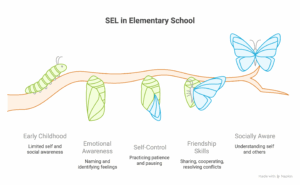Beyond Grades: Why Social Emotional Learning Matters from Childhood to Graduation
Beyond Grades: Why Social Emotional Learning Matters from Childhood to Graduation

Education today is about more than test scores. To thrive, young people need skills that help them manage emotions, build relationships, and make thoughtful decisions. These are the foundations of Social Emotional Learning (SEL). When nurtured from elementary school through high school, SEL not only improves academic success but also equips students with life skills for the future.
In the early years, children are just learning how to understand themselves and others. SEL at this stage focuses on:
- Emotional awareness: Naming and identifying feelings.
- Self-control: Practicing patience and learning to pause before reacting.
- Friendship skills: Sharing, cooperating, and resolving simple conflicts.
Creative strategies: teachers can use feelings check-ins with mood charts, storytelling and role play to practice empathy, and classroom responsibilities that encourage teamwork and accountability.
Adolescence brings rapid changes in emotions, friendships, and identity. Middle schoolers need guidance in:
- Self-awareness: Recognizing strengths and personal values.
- Relationship skills: Handling peer pressure, disagreements, and social dynamics.
- Responsible decision-making: Weighing choices and consequences.
Creative strategies: reflective journaling, collaborative projects, short mindfulness practices, and peer mentoring programs give students practical ways to strengthen their skills.
High school students juggle academic pressure, social expectations, and decisions about their future. SEL at this stage emphasizes:
- Resilience and stress management: Balancing school, work, and relationships.
- Empathy and respect: Preparing to engage with diverse communities.
- Future planning: Linking daily habits with long-term goals.
Creative strategies: debates and discussions to build respectful communication, service-learning projects to foster responsibility, and real-world simulations (like budgeting or mock interviews) that develop problem-solving and confidence.
SEL is most powerful when combined with life skills education. Instead of being an “extra subject,” life skills can be woven into academic lessons:
- In math, students can learn financial literacy through budgeting.
- In language arts, they can practice communication and conflict resolution through debates or storytelling.
- In science, teamwork and ethical discussions help students apply collaboration and critical thinking.
- In civic education, students explore leadership and responsible citizenship.
This integration ensures that learning connects to real life, preparing students to use knowledge in practical, meaningful ways.
Research shows SEL improves academic performance, reduces behavioral issues, and creates more positive classroom environments. But beyond school, it helps students grow into resilient, empathetic, and adaptable individuals. Whether it’s a child learning to name emotions, a middle schooler navigating friendships, or a high schooler preparing for adult responsibilities, SEL provides tools for success in every stage of life.
When schools prioritize Social Emotional Learning and embed life skills into the curriculum, they shape not only smarter students but also stronger individuals. By nurturing SEL consistently from childhood through adolescence, we prepare young people to graduate with confidence, compassion, and the ability to thrive in an ever-changing world.

